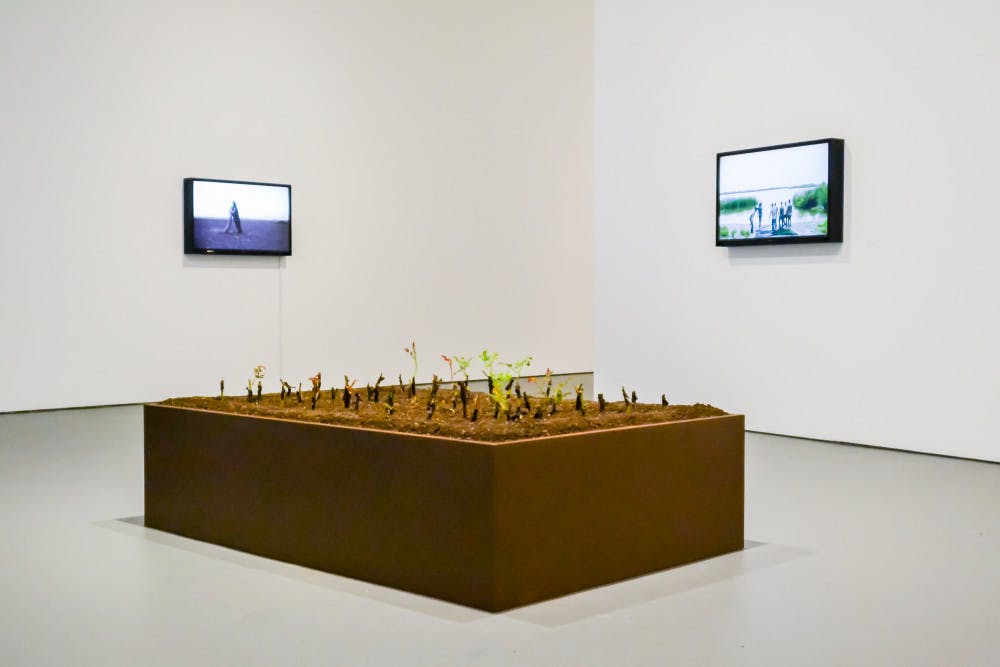Plaintively strewn Damask flowers, grief-stricken video displays of Turkish newspapers and a demoralizing lithograph enumerating the fallen speak volumes about the concrete consequences of borders in Fatma Bucak’s exhibit, “And Men Turned Their Faces From There.”
The installation, which opened Nov. 19 in the List Art Center’s Bell Gallery, examines the nuanced plight of the Kurdish people in Turkey. Dubbed “the most relevant exhibition of 2016” by Rhode Island Monthly, the exhibit serves as an arresting and eye-opening testament to the experiences of the Kurds living along the Turkish-Syrian border.
Bucak was born in Iskenderun, Turkey — a town that skirts the Syrian border and wholly embodies the artist’s sense of liminality. No stranger to border issues as a Turkish-born Kurd, Bucak addresses the concerns of the Kurdish population and the broader Syrian migration crisis with authority.
Her latest exhibit encompasses a broad range of mediums that navigate their own precarious artistic borders. Everything from video performances depicting women scrubbing Turkish newspapers as a commentary on the press to a series of 84 photographs is on full display. These components each instance a particular “ethical intentionality,” said Bell Gallery Curator Ian Russell, who came to know the artist during his time abroad in Turkey.
Bucak “just has this inexplicable, innate ability to render beautiful images,” Russell said. “That’s what initially attracted me to her work.”
But what really elevates Bucak’s work is the counter-cultural creative’s capacity to explore delicate issues of geography and politics, Russell added.
“Art can be a very powerful platform for people to reflect on these situations,” he said, highlighting the relevance of Bucak’s exhibit not only to the ongoing Syrian refugee crisis, but also to the United States’ own border issues. “I’ll always be attracted to that aspect of art.”
Russell, as a curator for the University, carries a certain responsibility to spotlight the work of underrepresented artists. “I really feel I best serve the Brown community as a sort of advocate,” Russell said, noting his ethical duty to seek grants from foundations that make new works in the Bell Gallery possible.
In accordance with Russell’s vision, he partnered Bucak with the AS220 print shop, which aided her in mending the exhibit’s lithograph. The lithograph, a composite of magnesium carbonate and the crushed rubble of the homes of Kurdish citizens destroyed by Turkish forces, serves as a canvas on which Bucak inscribed the names of those victimized by the crisis.
Though not as explicit in illustrating the profound tragedies created by borders, the Damask flowers might be the exhibit’s most singular display. Bucak’s intention was for the exhibit to contain 150 flowers. Brought to Providence from Syria via Lebanon and Turkey, the flowers took a circuitous journey that led to the destruction of 100 of them by Italian customs and Syrian border patrol. Bucak, in the apotheosis of her formidable resilience to the migratory issues of the 21st century, hand carried the remaining 50 on her journey across the Atlantic.
“And Men Turned Their Faces From There” will be on display until Feb. 5. While her work’s tenure in the Bell Gallery might be limited to a few months, Bucak, riding out the political tides of change, crests a new creative wave with the exhibit’s uncanny sense of relevance.





